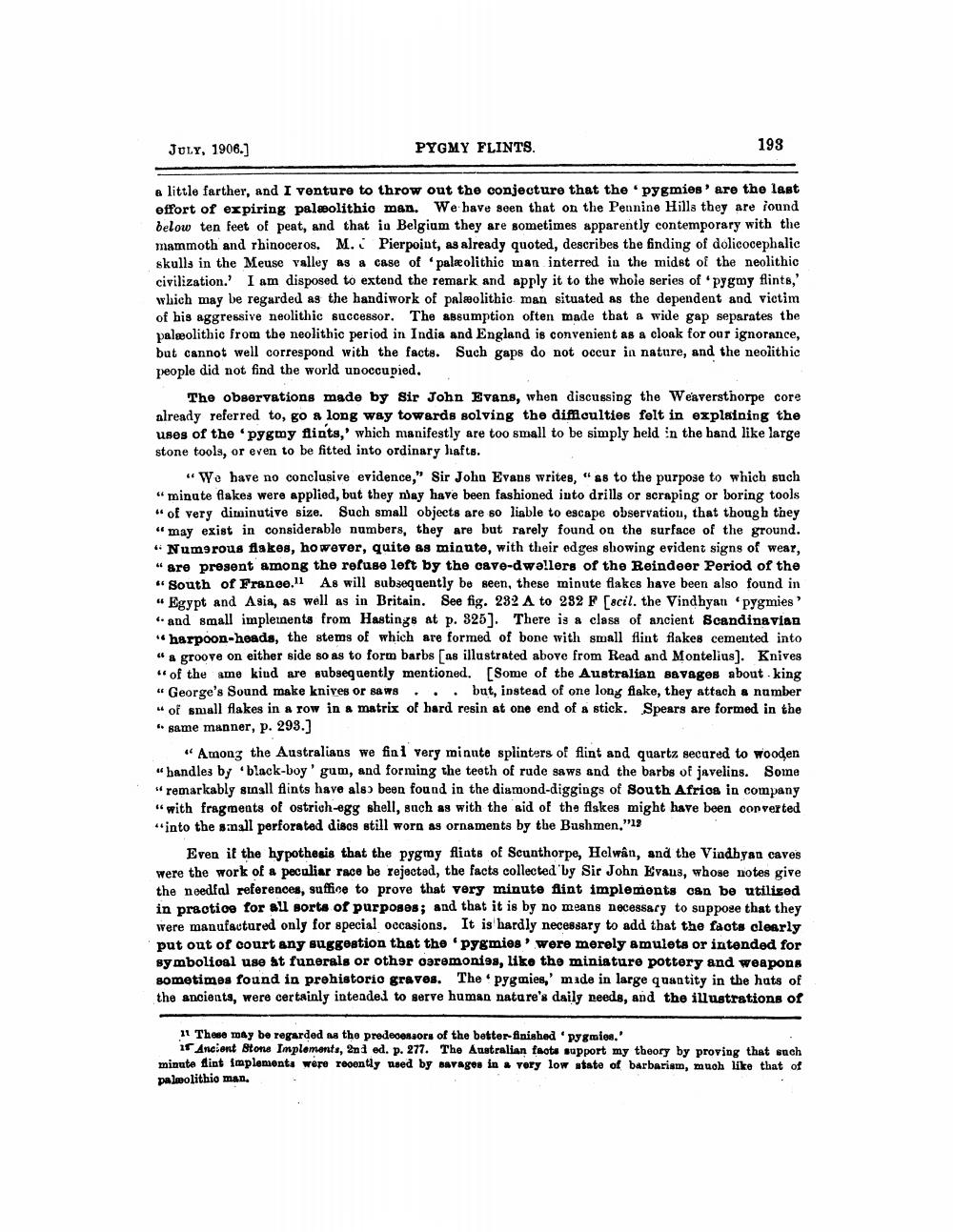________________
JULY, 1906.]
PYGMY FLINTS.
193
a little farther, and I venture to throw out the conjecture that the 'pygmies' are the last effort of expiring paleolithic man. We have seen that on the Pennine Hills they are found below ten feet of peat, and that in Belgium they are sometimes apparently contemporary with the mammoth and rhinoceros. M. Pierpoint, as already quoted, describes the finding of dolicocephalic skulls in the Meuse valley as a case of paleolithic man interred in the midst of the neolithic civilization.' I am disposed to extend the remark and apply it to the whole series of 'pygmy flints,' which may be regarded as the handiwork of paleolithic man situated as the dependent and victim of his aggressive neolithic successor. The assumption often made that a wide gap separates the paleolithic from the neolithic period in India and England is convenient as a cloak for our ignorance, but cannot well correspond with the facts. Such gaps do not occur in nature, and the neolithic people did not find the world unoccupied.
The observations made by Sir John Evans, when discussing the Weaversthorpe core already referred to, go a long way towards solving the difficulties felt in explaining the uses of the 'pygmy flints,' which manifestly are too small to be simply held in the hand like large stone tools, or even to be fitted into ordinary hafts.
"We have no conclusive evidence," Sir John Evans writes, "as to the purpose to which such "minute flakes were applied, but they may have been fashioned into drills or scraping or boring tools "of very diminutive size. Such small objects are so liable to escape observation, that though they "may exist in considerable numbers, they are but rarely found on the surface of the ground. Numerous flakes, however, quite as minute, with their edges showing evident signs of wear, "are present among the refuse left by the cave-dwellers of the Reindeer Period of the "South of France. As will subsequently be seen, these minute flakes have been also found in "Egypt and Asia, as well as in Britain. See fig. 232 A to 232 F [scil. the Vindhyau 'pygmies' and small implements from Hastings at p. 325]. There is a class of ancient Scandinavian "harpoon-heads, the stems of which are formed of bone with small flint flakes cemented into "a groove on either side so as to form barbs [as illustrated above from Read and Montelius]. Knives "of the ame kind are subsequently mentioned. [Some of the Australian savages about king "George's Sound make knives or saws... but, instead of one long flake, they attach a number "of small flakes in a row in a matrix of hard resin at one end of a stick. Spears are formed in the "same manner, p. 293.]
"Among the Australians we find very minute splinters of flint and quartz secured to wooden "handles by "black-boy' gum, and forming the teeth of rude saws and the barbs of javelins. Some "remarkably small flints have also been found in the diamond-diggings of South Africa in company "with fragments of ostrich-egg shell, such as with the aid of the flakes might have been converted "into the small perforated discs still worn as ornaments by the Bushmen."12
Even if the hypothesis that the pygmy flints of Scunthorpe, Helwân, and the Vindhyan caves were the work of a peculiar race be rejected, the facts collected by Sir John Evans, whose notes give the needfal references, suffice to prove that very minute flint implements can be utilised in practice for all sorts of purposes; and that it is by no means necessary to suppose that they were manufactured only for special occasions. It is hardly necessary to add that the facts clearly put out of court any suggestion that the 'pygmies' were merely amulets or intended for symbolical use at funerals or other ceremonies, like the miniature pottery and weapons sometimes found in prehistoric graves. The 'pygmies,' made in large quantity in the huts of the ancients, were certainly intended to serve human nature's daily needs, and the illustrations of
11 These may be regarded as the predecessors of the better-finished 'pygmies."
1 Ancient Stone Implements, 2nd ed. p. 277. The Australian facts support my theory by proving that such minute flint implements were recently used by savages in a very low state of barbarism, much like that of paleolithic man.




